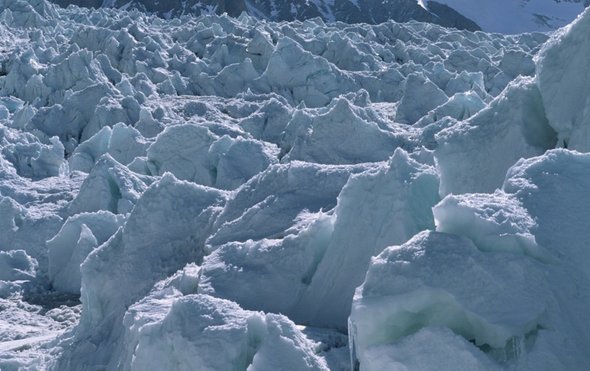(单词翻译:单击)
听力文本
Hi, I'm Scientific American podcast editor Steve Mirsky. And here's a short piece from the April issue of the magazine, in the section we call Advances: Dispatches from the Frontiers of Science, Technology and Medicine:
Glacial Sprint by Katherine Kornei
Most glaciers creep along at a pace that is, well, glacial. But one in northern Pakistan breaks into a gallop with astounding speed and regularity: Khurdopin glacier "surges" every two decades, moving roughly 1,500 times its normal pace. This sends ice tumbling into a nearby river, damming it to create a temporary lake that can suddenly inundate nearby villages. Now scientists in Europe have used new high-resolution satellite data to study Khurdopin before and during its most recent surge in 2017, revealing how the event developed on a near daily basis, in unprecedented detail. The observations are critical to monitoring the glacier's hazards and could help to predict when flooding might occur next.
About 1 percent of the world's glaciers exhibit such sudden and large bursts of speed. Jakob Steiner, a geoscientist at Utrecht University in the Netherlands, who led the study said, "It's not 100 percent clear why some glaciers surge and others don't." Some scientists think water permeates a glacier's base and acts as a lubricant to promote sliding. Sediments between a glacier and the ground may also facilitate slippage.

Steiner and his team analyzed new satellite images of Khurdopin that revealed features as small as three meters across. As snow accumulated on the high-elevation end of the 41-kilometer river of ice, the crushing pressure changed the structure of the water molecules, causing the ice to melt at lower temperatures and allowing the mass to suddenly shift. Khurdopin surged up to 20 meters a day in May 2017, creating a lake that grew to 30 times its size before draining and washing away roads, bridges and farmland, the scientists reported in January in The Cryosphere.
Steiner and his colleagues plan to return to Pakistan this year to continue installing temperature and rain sensors around Khurdopin and training area residents to monitor the glacier and its transient lake.
That was Glacial Sprint by Katherine Kornei.
参考译文
大家好,我是《科学美国人》播客编辑史蒂夫·米尔斯基。下面给大家介绍收录在本杂志四月刊“进展:科学、技术和医学前沿快报”版块的一篇短文。
《冰川冲刺》——凯瑟琳·柯尔纳
大多数冰川的移动速度都……嗯……很缓慢。但是巴基斯坦北部地区的一座冰川却突然以惊人的速度和频率飞奔:这座名为Khurdopin的冰川每20年“爆发”一次,移动速度为其正常速度的1500倍左右。这种爆发使冰块掉入附近的河流,阻拦河水,形成可瞬间淹没周围村庄的临时湖泊。现在,欧洲科学家利用新的高分辨率卫星数据,来研究Khurdopin冰川在2017年最近一次“爆发”前夕和期间的情况,以前所未有地详尽展示冰川几乎每日的变化情况。这些观察结果对监控冰川的危害至关重要,同时还能帮助预测下次洪灾可能发生的时间。
世界上约有1%的冰川会出现这种突然且大幅的增速。荷兰乌得勒支大学的地质学家兼这项研究的领导者雅各布·斯坦纳表示,“目前还不能百分之百地确定为何有些冰川会突然增速,而其他冰川却不会。”一些科学家认为,水渗入了冰川底部,作为润滑剂促进冰川滑行。冰川和地面之间的沉积物可能也会助力冰川的滑行。
斯坦纳和团队分析了Khurdopin冰川的最新卫星图片,这些图片揭示该冰川的宽度只有3米。由于雪堆积在41千米长的冰河高海拔端,压溃压力改变了水分子的结构,导致冰在更低的温度融化,使冰川突然移动。2017年5月,Khurdopin冰川每日的移动距离高达20米,这导致一个湖的水量增长了30倍,随后水溢出并冲毁了道路、桥梁和农田,科学家在《冰冻圈》期刊1月刊中报告了这一情况。
斯坦纳和同事计划今年回到巴基斯坦,继续在Khurdopin冰川附近安装温度及雨水感应器,同时培训当地居民监测冰川及其形成的临时湖泊。
以上是凯瑟琳·柯尔纳发表的文章《冰川冲刺》。
译文为可可英语翻译,未经授权请勿转载!
重点讲解
重点讲解:
1. break into 突然开始做(某事);
The moment she was out of sight she broke into a run.
她一走出众人的视线就开始飞奔起来。
2. in detail 详细地;全面地;仔细地;
In this section we will analyze the business case and problem in detail.
在本部分中,我们将详细分析业务案例和问题。
3. act as 起作用;充当;
A trained dog can act as a guide to a blind person.
经过训练的狗能担任盲人的向导。
4. wash away 冲垮;冲走;
Flood waters washed away one of the main bridges in Pusan.
洪水冲垮了釜山的一座主要桥梁。


